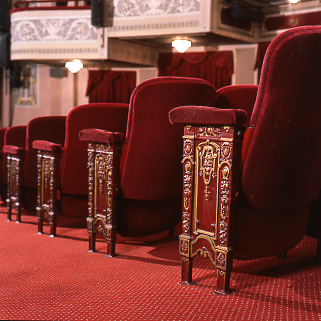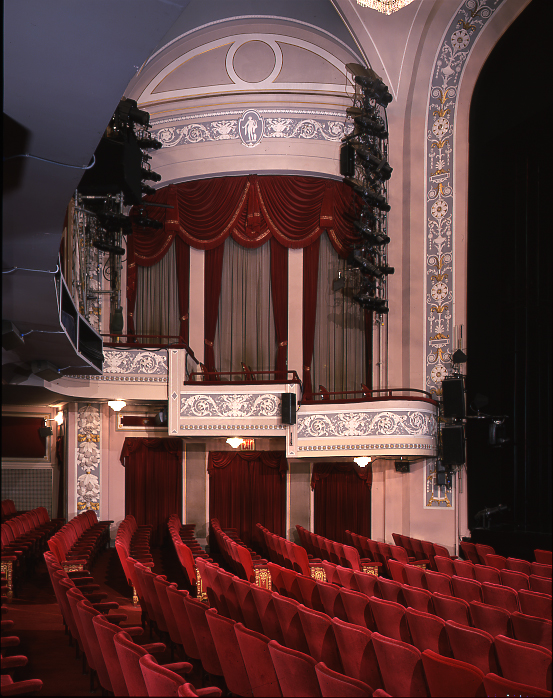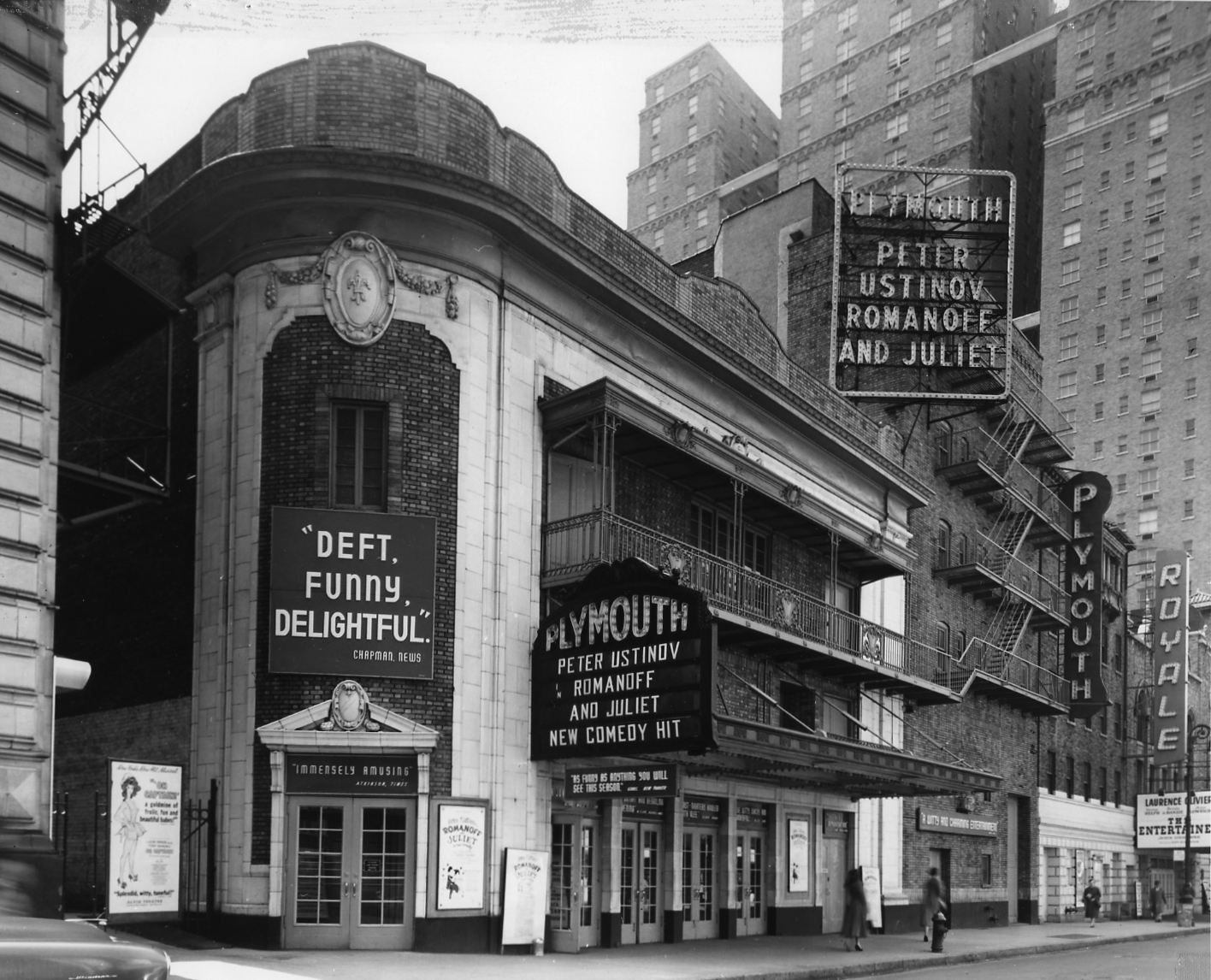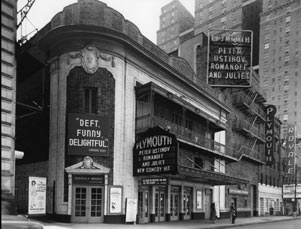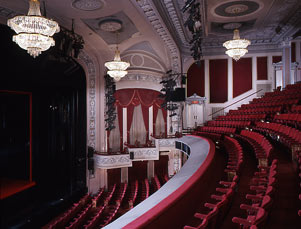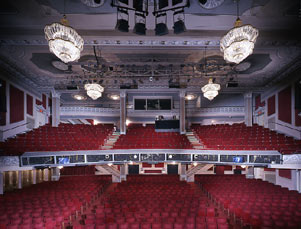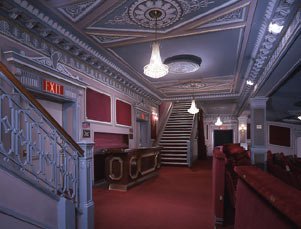ON STAGE
Now Playing
THE NOTEBOOK
HISTORY
The Shuberts built the Gerald Schoenfeld Theatre (formerly the Plymouth) along with the contiguous Broadhurst in 1917. The playhouse was initially leased to producer Arthur M. Hopkins who achieved much success in booking it. It was renamed the Gerald Schoenfeld in 2005 to honor the late chairman of the Shubert Organization.
ARCHITECTURE
The Schoenfeld was the architect Herbert Krapp’s first independent commission. The interior design motifs, including the Adamsesque detailing, subtly reflect those of the somewhat more ornate Booth and Shubert.
Spotlight on Broadway: Gerald Schoenfeld Theatre from Spotlight on Broadway on Vimeo.
Details on the Gerald Schoenfeld Theatre's Accessibility
Access Information
Theatre is not completely wheelchair accessible. There are no steps into the theatre from the sidewalk. Please be advised that where there are steps either into or within the theatre, we are unable to provide assistance.
Shubert Audience Services
The Gerald Schoenfeld Theatre provides accommodations for patrons who are blind, deaf, partially sighted, and/or have hearing loss. The theatre provides infrared assistive listening devices for every performance at the theatre. In addition, beginning four weeks after a show’s official opening night performance, hand-held audio description devices, hand-held captioning devices, and unlimited access to downloadable audio description and/or captioning for personal mobile devices are all available free of charge. Prior thereto, we offer live-caption via CART using a hand-held device, upon request with two-weeks’ advance notice. For assistance, or If you have questions, contact Shubert Audience Services at 212-944-3700 or audienceservices@shubertorg.com. There is also a representative at the Shubert Audience Services kiosk at every performance to assist any patron with any of our devices, software, or technology. Hand-held devices are limited, although additional devices can be obtained with at least twenty-four hours’ notice.
Accessibility by Seating Section
Orchestra Location: Seating is accessible to all parts of the Orchestra without steps. There are no steps to the designated wheelchair seating location.
Mezzanine Location: Located on 2nd level, up 1 flight of stairs (31 steps). Please Note: On the Mezzanine level, there are approximately 2 steps down per row. Entrance to Mezzanine is behind row K.
Handrails: Available at the end of every stepped seat row in the Mezzanine.
Wheelchair | Companion Seat Locations:
Orchestra: S102 | S101, R101-102; S111 | S112, R109-110; R23 | R17-21; S4 | R6-8; S15 | S17, R13-15; S3 | S1, R5-7; S11 | S9, R9-11
Aisle Seat with Folding Armrest | Companion Locations:
Orchestra: N114 | N113; M28 | M26; O26 | O24; R1 | R3
Elevators/Escalator
None Available
Restroom
A wheelchair accessible restroom (unisex) is located on the main level.
Water Fountain
Located in restrooms.
Theatre Policies
The use of cameras, recording devices, cell phones, beepers, and other electronic devices during the performance is prohibited, except as permitted for accessibility services. Everyone attending a performance must have a ticket. Latecomers will be seated at the discretion of management. Wheelchair and mobility-impaired seating is intended for patrons with mobility disabilities. Children under the age of four years will not be admitted. No outside food or beverage permitted, unless medically necessary. No weapons permitted on the premises.
NOW PLAYING
THE NOTEBOOK
The Notebook is a new hit musical based on the best selling novel that inspired the iconic film. Allie and Noah, both from different worlds, share a lifetime of love despite the forces that threaten to pull them apart, in a deeply moving portrait of the enduring power of love.
The Notebook is “full of butterfly-inducing highs, stunning performances, and beautiful songs” (Entertainment Weekly). Chris Jones of The Chicago Tribune says The Notebook is “absolutely gorgeous, not to be missed,” and The New York Daily News calls it “a love story for the ages.”
The Notebook is directed by Michael Greif (Dear Evan Hansen, Next to Normal, RENT) and Schele Williams (The Wiz, Aida) and features music and lyrics by multi-platinum singer-songwriter Ingrid Michaelson, book by Bekah Brunstetter (NBC’s This Is Us), and choreography by Katie Spelman.
The Notebook Show Tickets
COMING SOON
BUENA VISTA SOCIAL CLUB
"The full-of-riches new musical brings a classic record to life." - Jesse Green, The New York Times
Step into the heart of Cuba, beyond the glitz of the Tropicana, to a place where blazing trumpets, and sizzling guitars set the dance floor on fire. Here the sound of Havana is born – an one woman’s remarkable journey begins.
Inspired by true events, the new Broadway musical Buena Vista Social Club brings the Grammy® Award-winning album to thrilling life —and tells the story of the legends who lived it. A world-class Afro-Cuban band is joined by a sensational cast in this unforgettable tale of survival, second chances, and the extraordinary power of music.
"Give yourself over to Buena Vista Social Club." (Time Out New York)
Buena Vista Social Club Show Tickets
The Schoenfeld's inaugural production was A Successful Calamity (1917), followed by a trio of Ibsen plays: The Wild Duck (1918), Hedda Gabler (1918) and A Doll’s House (1918). John Barrymore then starred in Tolstoy’s Redemption (1918). In the post-war period, Hopkins staged What Price Glory? (1924), significant for its boldly realistic depiction of soldiers at war. Other highlights of the 1920s were Burlesque (1927) starring Barbara Stanwyck and two Hope Williams vehicles: Holiday (1928) and Rebound (1930).
The 1930s, 1940s and 1950s included a number of notable productions and Pulitzer Prize winners. Tovarich (1936) was followed by Rachel Crother’s Susan and God (1937) which featured Gertrude Lawrence in a standout performance. Abe Lincoln in Illinois (1938) and Thornton Wilder’s The Skin of Our Teeth (1942) starring Tallulah Bankhead both won the Pulitzer Prize. Bankhead returned to the Schoenfeld in Noel Coward’s Private Lives (1948). Eva Gabor played in The Happy Time (1950), followed by Dial M for Murder (1952), and The Caine Mutiny Court-Martial (1954). Harry Belafonte starred in the musical Three for Tonight (1955).
The racy musical Irma La Douce (1960) kicked off the 1960s. In the second half of the decade, the house played host to a string of plays by Neil Simon: The Odd Couple (1965) starring Art Carney and Walter Matthau, The Star-Spangled Girl (1966) featuring Anthony Perkins, Plaza Suite (1968) with George C. Scott and Maureen Stapleton, and The Gingerbread Lady (1970), again starring Maureen Stapleton.
A number of British plays premiered at the Schoenfeld in the 1970s and 80s. Dudley Moore and Peter Cook’s Good Evening (1973) was followed by Peter Shaffer’s Equus (1974) with Anthony Hopkins. The Shuberts co-produced a dramatic version of Charles Dickens’s The Life & Adventures of Nicholas Nickleby (1981). David Hare’s Plenty (1983) starred Kate Nelligan and Edward Herrmann. Next was another Shubert co-production, Tom Stoppard’s The Real Thing (1984), featuring Jeremy Irons and Glenn Close, directed by Mike Nichols.
Other distinguished productions of the 1980s and 90s include Lily Tomlin’s one-woman show The Search for Signs of Intelligent Life in the Universe (1985) and Wendy Wasserstein’s Pulitzer Prize-winning The Heidi Chronicles (1989) starring Joan Allen. Irish playwright Brian Friel had three premiers at the Schoenfeld in the 1990s: Dancing at Lughnasa (1991), Wonderful Tennesee (1993) and Translations (1995). The Shuberts co-produced the Stephen Sondheim musical Passion (1994). A revival of Edward Albee’s A Delicate Balance (1996) and Frank Wildhorn’s Jekyll & Hyde (1997) followed.
An acclaimed revival of Eugene O’Neill’s Long Day’s Journey Into Night (2003) starring Vanessa Redgrave, Brian Dennehy, Philip Seymour Hoffman, and Robert Sean Leonard; Taboo (2003), a musical by Boy George; a revival of A Chorus Line (2006); a revival of All My Sons (2008); A Steady Rain starring Hugh Jackman and Daniel Craig; and Martin McDonagh’s A Behanding in Spokane (2010) with Christopher Walken all shared the stage at the Schoenfeld.
Recent productions include a A Life in the Theatre (2010) with Patrick Stewart, The Mother****** with the Hat (2011) with Chris Rock, the musical Bonnie and Clyde (2011) and revivals of The Best Man (2012) and Glengarry Glen Ross (2012). A starry It's Only a Play (2014) followed as did Helen Mirren in The Audience (2015), the Tony Award winning play The Humans (2016) and the musical Come From Away (2017).
THEATRE SPECS
Gerald Schoenfeld Theatre
236 West 45th Street
Between Broadway and 8th Avenue
New York NY 10036
| Year Built |
|
1917 |
| |
| Seating Capacity |
|
1079 Total |
| Orchestra |
|
653 |
| Mezzanine |
|
392 |
| Boxes |
|
24 |
| Standing |
|
15 |
| Total |
|
1084 |
| |
|
|
| Included in Numbers Above: |
|
|
| Orchestra Pit |
|
36 |
| Wheelchair |
|
7 |
| Aisle Transfer Arm |
|
11 |
| |
| Theatre Dimensions |
|
| Proscenium Opening: |
40' 0" |
| Height of Proscenium: |
38' 0" |
| Depth to proscenium: |
26' 9" |
| Depth to front of stage: |
28' 3" |
| Stage Type: |
Proscenium |
| |
SEATING CHART
